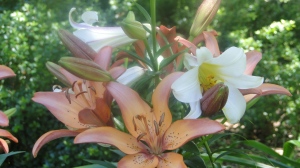Native to southern Japan and Taiwan, this Division IX lily features large, white, fragrant, trumpet-like flowers that usually bloom in July-August. Plants which flower during Easter have been forced.
Lilium longiflorum (Easter Lily, Trumpet Lily)
Deciduous: yes
Hardiness Zones: 4-8
Height: 60-90 centimeters (24-36 inches) tall
Diameter: 22-30 centimeters (9-12 inches) wide
Growth Rate: moderate
Age: perennial
Root System: shallow
Family: Liliaceae
Subspecies: ‘White Heaven’
Tolerates: some shade, damp soils
Problems (major): Do not allow the soil to dry out, this can be fatal.
Problems (minor): strong winds and excessive shade (stalk these plants to secure the stem), aphids, lily mosaic virus, bulb rot, Botrytis, leaf spots, gray mold, root
rot, bulb borers, spider mites
Poisonous: no toxins known
Soil requirements: prefer somewhat moist, nutrient-rich, well-drained soils
Air requirements: not sufficiently researched
Watering requirement: demand consistently moderately moist soils (not too wet, though)
Sun requirement: full sun to part-shade
Leaf shape: lanceolate, dark green
Leaf size: 12-20 centimeters (5-8 inches) long by 1 centimeter (0.5 inches) wide
Flower structure: trumpet-shaped, white, fragrant, 12-18 centimeters (5-7 inches) long
Flowering frequency: July-August
Bulb/tuber: bulb
Monocot/Dicot: monocot
Annual/Biennial/Perennial: perennial
Notable characteristics:
The flowers are large and fragrant. The bulbs sometimes divide, producing new plants.
Uses:
Easter Lilies are primarily used as ornamentals. They should be planted 10-20 centimeters (4-8 inches) in the soil and covered by mulch. Plant these anytime from
early spring to autumn on a non-western side of your home. A 5-10-5 (Nitrogen-Phosphorus-Potassium, NPK) fertilizer will promote overall health and blooms.
Once the folige yellows and the blooms die, they should be cut back to the ground. The seeds require typically 3 years of growth before it will begin flowering.
Sources used:
- http://www.missouribotanicalgarden.org/PlantFinder/PlantFinderDetails.aspx?kempercode=e953
- http://plants.usda.gov/core/profile?symbol=LILO3
- http://pss.uvm.edu/pss123/fplili.html
- http://county.wsu.edu/chelan-douglas/gardening/MG/Documents/easterlily.pdf
- http://www.pfaf.org/user/Plant.aspx?LatinName=Lilium+longiflorum

Trumpet Lilies behind another variety of lily
All of the images provided were taken by me. They may be used for educational/informational purposes only, provided that this article/online journal is
appropriately cited first.

